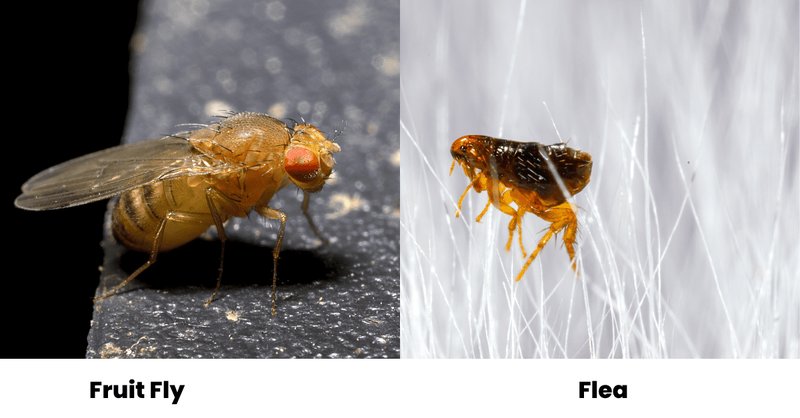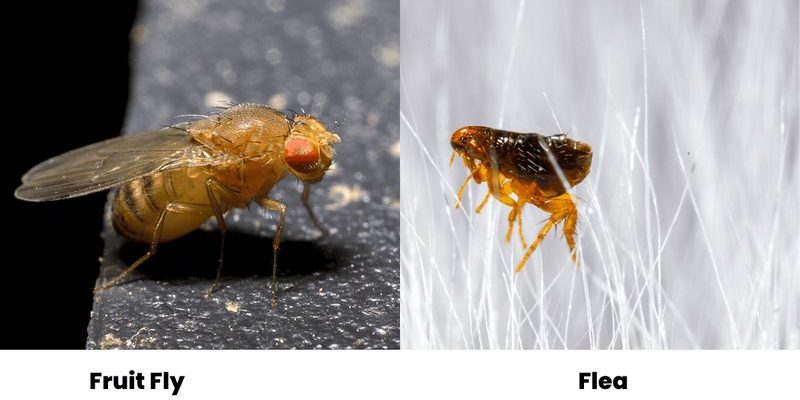
Imagine you’re at a bustling café, sipping coffee, and watching the world go by. Now, picture those little winged visitors darting around your cup. At first glance, they might seem like just a nuisance, but they each play a role—both in ecosystems and in our everyday lives. By recognizing the differences between fruit flies and their relatives, you can better understand their behaviors and what attracts them to your home.
What Are Fruit Flies?
Fruit flies, scientifically known as *Drosophila melanogaster*, are tiny insects that are often less than 1/8 inch long. They have a distinctive tan or yellow-brown body with red eyes, making them easy to spot. You might notice them hovering around your ripe bananas or apples, and it can feel like they multiply overnight!
These insects thrive in places where decaying fruits and vegetables are present. It’s almost as if they have a built-in GPS leading them straight to your kitchen counter. Their life cycle is speedy; from egg to adult can take as little as a week under perfect conditions. This rapid reproduction ability is why they seem to appear out of nowhere.
Fruit flies are not just pests; they are widely used in genetic research. Scientists often study them because they share many genetic similarities with humans. So, while they may seem annoying, they actually play a critical role in advancing our understanding of genetics!
Common Lookalikes: The Vinegar Fly
The vinegar fly, another member of the *Drosophila* family, might easily be confused with the common fruit fly. In fact, they are so similar that it often requires a closer look to tell them apart. Vinegar flies are typically found in damp environments, especially those rich in organic matter.
You might spot them around fermentation processes, like in your open wine bottle or on that jar of forgotten pickles. Their love for vinegar is a telling sign; if you’ve got a half-empty bottle sitting around, you might attract these little guys instead of—or in addition to—fruit flies.
The main difference lies in their behavior. While fruit flies are drawn to ripe or rotting fruits, vinegar flies are more attracted to the smell of acetic acid—the main component in vinegar. This pungent scent draws them in, and you might find them in kitchens where food waste isn’t managed properly.
Another Relative: The House Fly
House flies, or *Musca domestica*, could easily hold the title of “most annoying fly,” given their tendency to invade our living spaces. Unlike fruit flies, they’re slightly larger (about 1/4 inch) and have a more grayish body, making them easier to identify.
Here’s the thing: house flies are not picky eaters. They’ll feed on a variety of organic materials, including garbage and animal waste, which can lead to health risks if they invade your home. Their attraction to food waste and decaying matter makes them more of a concern than fruit flies.
Interestingly, house flies also have a quicker life cycle, though they generally reproduce less frequently than fruit flies. Their high adaptability allows them to survive in various environments, further complicating pest control in our homes.
Identifying the Differences
Now that we’ve looked at fruit flies and their similar insects, you might be wondering how to identify them. Here’s a simple comparison to help you remember:
| Insect | Size | Color | Attraction |
| Fruit Fly | 1/8 inch | Tan/yellow-brown with red eyes | Ripe fruits |
| Vinegar Fly | 1/8 inch | Similar to fruit fly | Vinegar and fermented foods |
| House Fly | 1/4 inch | Gray | Decaying organic matter |
When it comes to distinguishing between them, pay attention to their environments. Where are you finding them? What do they seem attracted to? The answers to these questions can help you pinpoint the pesky critters buzzing around your space.
Why Do They Matter?
You might be thinking, “Why should I care about these insects?” Well, they’re not just annoying house guests; they play significant roles in our ecosystems. For example, fruit flies help with pollination, and their rapid life cycles are vital for ecological studies.
Furthermore, understanding these insects can help you manage them better. By recognizing what attracts fruit flies versus house flies, you can take steps to reduce their presence in your kitchen. Good practices like properly storing food, regularly cleaning surfaces, and managing waste can make a big difference.
How to Manage Fruit Flies and Their Relatives
Now that we’ve covered the basics, let’s talk about how to keep these insects at bay. If fruit flies are your primary concern, start by:
- Storing fruits and veggies in the fridge or in airtight containers.
- Cleaning up spills immediately to avoid attracting them.
- Taking out the trash regularly to reduce their food sources.
For vinegar flies, ensure that any unsealed vinegar bottles or jars are tightly capped. And for house flies, consider using screens on windows and doors to limit their entry.
Honestly, a little bit of prevention goes a long way. By implementing these simple strategies, you can enjoy your kitchen without the buzz of unwanted guests.
Understanding the differences between fruit flies and similar insects like vinegar and house flies can make dealing with them much easier. While they can be annoying, approaching the situation with knowledge gives you power.
By knowing what attracts these insects, you can take steps to keep your home pest-free. Whether it’s through proper food storage, regular cleaning, or simply being aware of their behaviors, you can reclaim your kitchen and enjoy your fruits without the buzz of unwanted guests. Remember, it’s all about balance—between welcoming those sweet fruits and keeping the pesky flies at bay.

